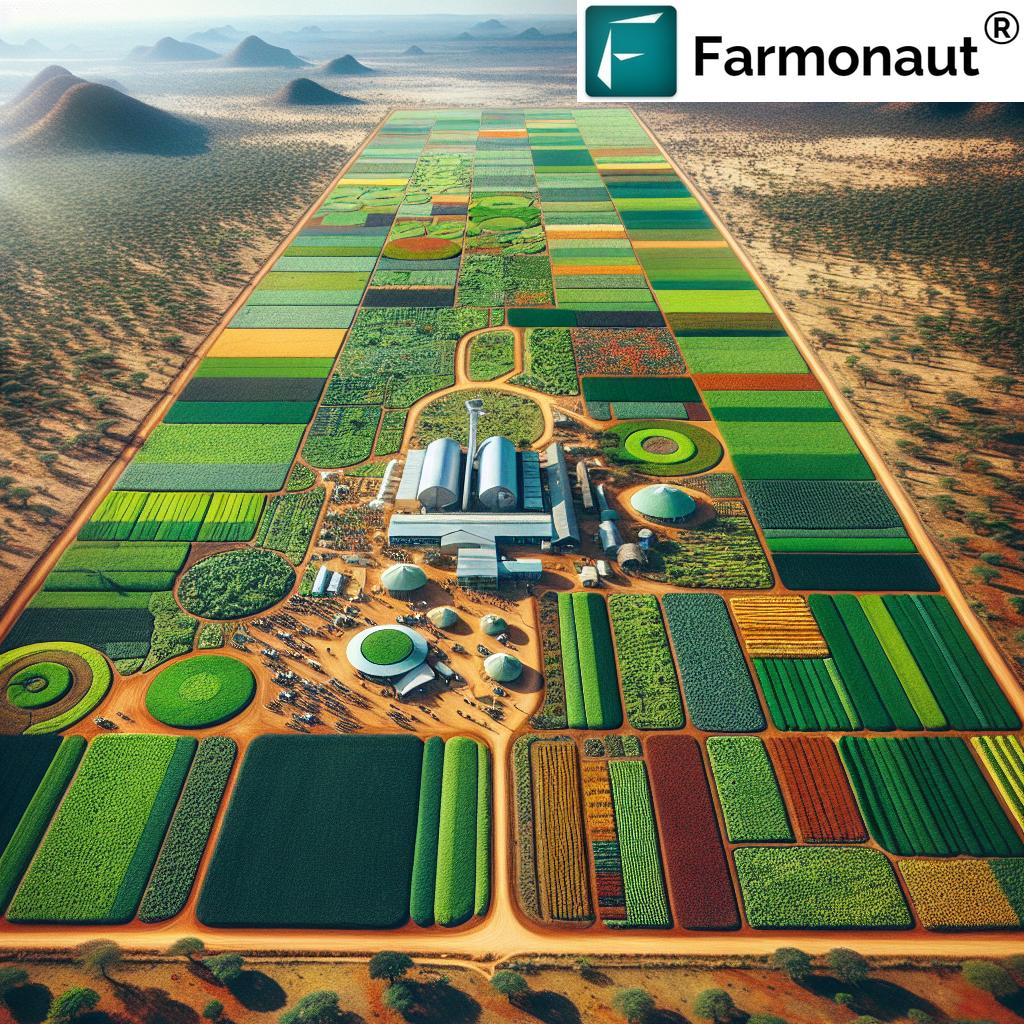Namibia’s Green Revolution: How the Kalimbeza Rice Project is Transforming Food Security in the Zambezi Region
“The Kalimbeza Rice Project in Namibia’s Zambezi Region spans over 229 hectares of cultivated land.”
In the heart of southern Africa, a green revolution is taking root, transforming the landscape and lives of people in Namibia’s Zambezi Region. We’re witnessing a remarkable journey of agricultural growth and food security, centered around the visionary Kalimbeza Rice Project. This initiative is not just about growing rice; it’s about cultivating hope, sustainability, and a brighter future for Namibia.
The Seeds of Change: Namibia’s Agricultural Renaissance
Namibia, a country known for its vast deserts and stunning wildlife, is now making headlines for a different reason – its burgeoning agricultural sector. At the forefront of this transformation is the Kalimbeza Rice Project, a testament to the nation’s commitment to food self-sufficiency and sustainable farming practices.
Located near Katima Mulilo in the fertile Zambezi Region, the Kalimbeza Rice Project is more than just a farming initiative. It’s a symbol of Namibia’s determination to overcome food security challenges and position itself as a significant rice producer in Africa.

The Vision Behind Kalimbeza: A Legacy of Agricultural Development
The roots of the Kalimbeza Rice Project can be traced back to the visionary leadership of Namibia’s late Founding President, Sam Nujoma. His dream was to see Namibia emerge as one of Africa’s key rice producers, a vision that went beyond political rhetoric to become a tangible reality.
Patrick Kompeli, the manager of the Kalimbeza Rice Project, recalls Nujoma’s hands-on involvement: “Our founding father had agriculture at heart. He wanted to see that Namibian citizens don’t go to bed on an empty stomach. Hence, he pushed for the development of Green Schemes.”
This commitment to agricultural growth wasn’t just about food production; it was about empowering the nation, creating jobs, and ensuring a sustainable future for generations to come.
Green Schemes in Namibia: A Blueprint for Success
The Kalimbeza Rice Project is part of Namibia’s broader Green Scheme initiative, a comprehensive strategy aimed at boosting agricultural productivity and food security across the nation. These schemes are transforming the agricultural landscape, introducing modern farming techniques, and creating opportunities for both small-scale and commercial farmers.
Key features of Namibia’s Green Schemes include:
- Irrigation infrastructure development
- Technology transfer to local farmers
- Support for crop diversification
- Promotion of sustainable farming practices
- Creation of agro-processing opportunities
The success of these initiatives is evident in the growing interest from both local and international investors in Namibia’s agricultural sector.
Zambezi Region Agriculture: A Model for Sustainable Development
The Zambezi Region, with its rich soils and abundant water resources, is becoming a focal point for agricultural development in Namibia. The Kalimbeza Rice Project serves as a shining example of how targeted agricultural initiatives can transform a region’s economy and food security status.
Here’s how the project is making a difference:
- Increasing local rice production, reducing dependence on imports
- Creating employment opportunities for local communities
- Introducing sustainable farming practices
- Enhancing food security in the region and beyond
- Boosting the local economy through increased agricultural activity
Rice Cultivation in Katima Mulilo: Challenges and Triumphs
The journey of rice cultivation in Katima Mulilo hasn’t been without its challenges. From adapting to local climate conditions to managing water resources, the Kalimbeza Rice Project has faced and overcome numerous obstacles.
Some of the key challenges include:
- Adapting rice varieties to local conditions
- Managing pests and diseases
- Ensuring efficient water use in a semi-arid climate
- Training local farmers in rice cultivation techniques
- Developing market linkages for the produced rice
Despite these challenges, the project has seen remarkable success. The determination of the farmers, combined with support from agricultural experts and the government, has led to increasing yields and improved quality of rice produced in the region.
The Impact on Food Security in Africa
The Kalimbeza Rice Project is not just a local success story; it’s a beacon of hope for food security across Africa. As climate change and population growth put increasing pressure on food systems, initiatives like this demonstrate how targeted agricultural development can make a significant impact.
“Namibia’s Green Schemes aim to increase domestic rice production by 70% within the next five years.”
The project’s success has implications beyond Namibia’s borders:
- Demonstrating the potential for rice cultivation in semi-arid regions
- Providing a model for sustainable agricultural development
- Contributing to regional food security
- Inspiring similar initiatives in other African countries
By reducing dependence on imported rice and increasing local production, Namibia is taking significant steps towards food self-sufficiency, a goal that resonates with many African nations.

Sustainable Farming Practices: The Heart of Kalimbeza’s Success
At the core of the Kalimbeza Rice Project’s success is its commitment to sustainable farming practices. This approach not only ensures the long-term viability of the project but also protects the delicate ecosystem of the Zambezi Region.
Key sustainable practices implemented include:
- Efficient water management systems
- Integrated pest management
- Soil conservation techniques
- Use of organic fertilizers
- Crop rotation to maintain soil health
These practices are not only environmentally friendly but also contribute to higher yields and better quality rice, showcasing how sustainability and productivity can go hand in hand.
The Role of Technology in Namibian Agriculture
As we embrace the future of farming, technology plays a crucial role in enhancing agricultural productivity and sustainability. In this context, innovative solutions like those offered by Farmonaut are becoming increasingly relevant to projects like Kalimbeza.
Farmonaut’s satellite-based farm management solutions could potentially offer valuable insights for rice cultivation in Namibia. Their advanced technologies, including:
- Real-time crop health monitoring
- AI-based advisory systems
- Resource management tools
These tools could help farmers in the Zambezi Region optimize their rice production, manage resources more efficiently, and adapt to changing environmental conditions.
For more information on how satellite technology is revolutionizing agriculture, check out this insightful video:
While Farmonaut is not directly involved in the Kalimbeza Rice Project, its technologies represent the kind of innovative solutions that could further enhance agricultural initiatives in Namibia and across Africa.
The Economic Impact: Beyond the Rice Fields
The Kalimbeza Rice Project’s impact extends far beyond the boundaries of its fields. It’s creating a ripple effect that’s transforming the economic landscape of the Zambezi Region and contributing to Namibia’s broader agricultural growth.
Key economic benefits include:
- Job creation in farming and related industries
- Increased income for local farmers
- Development of agro-processing industries
- Boost to local businesses and services
- Contribution to Namibia’s GDP through increased agricultural output
This economic transformation is not just about numbers; it’s about changing lives, creating opportunities, and building a more prosperous future for the people of the Zambezi Region and Namibia as a whole.
The Human Story: Voices from Kalimbeza
Behind the statistics and strategies are the real heroes of the Kalimbeza Rice Project – the farmers and local community members whose lives have been transformed by this initiative.
Maria Nambinga, a local farmer, shares her experience: “Before the Kalimbeza project, I struggled to make ends meet. Now, as a rice farmer, I can provide for my family and even send my children to school. This project has given us hope for a better future.”
These personal stories highlight the profound impact of agricultural initiatives on individual lives and communities, underscoring the importance of such projects in achieving sustainable development and food security.
Looking Ahead: The Future of Rice Production in Namibia
As we look to the future, the Kalimbeza Rice Project stands as a model for agricultural development not just in Namibia, but across Africa. Its success has paved the way for expanded rice cultivation and increased food security in the region.
Future plans for the project include:
- Expanding the cultivated area
- Introducing new rice varieties
- Enhancing processing and packaging facilities
- Developing export markets for Namibian rice
- Integrating more advanced farming technologies
These plans reflect Namibia’s commitment to becoming a significant player in Africa’s rice production landscape, contributing to both national and regional food security.
The Role of Partnerships in Agricultural Growth
The success of the Kalimbeza Rice Project highlights the importance of partnerships in driving agricultural growth. While the project is primarily a government initiative, its success has been bolstered by collaboration with various stakeholders.
Key partnerships include:
- Cooperation with agricultural research institutions
- Support from international development agencies
- Collaboration with local farming communities
- Engagement with private sector entities in agro-processing
These partnerships have been crucial in overcoming challenges, sharing knowledge, and scaling up the project’s impact.
Lessons for Africa: Replicating Kalimbeza’s Success
The Kalimbeza Rice Project offers valuable lessons for other African countries looking to enhance their food security and agricultural productivity. Its success demonstrates the potential of targeted agricultural initiatives to transform rural economies and improve livelihoods.
Key lessons include:
- The importance of government commitment and vision
- The value of adapting crops and techniques to local conditions
- The need for comprehensive support systems for farmers
- The benefits of integrating sustainable farming practices
- The potential of technology in enhancing agricultural productivity
By applying these lessons, other African nations can develop their own successful agricultural initiatives, contributing to the continent’s overall food security and economic development.
The Global Context: Namibia’s Contribution to Food Security
In a world grappling with climate change and food insecurity, Namibia’s efforts through projects like Kalimbeza take on global significance. By increasing its rice production, Namibia is not only addressing its own food security needs but also contributing to the global food supply.
The project aligns with several Sustainable Development Goals (SDGs), including:
- SDG 2: Zero Hunger
- SDG 8: Decent Work and Economic Growth
- SDG 13: Climate Action
- SDG 15: Life on Land
This alignment showcases how local agricultural initiatives can have far-reaching impacts, contributing to global efforts to create a more sustainable and food-secure world.
Embracing Innovation: The Future of Farming in Namibia
As the Kalimbeza Rice Project continues to evolve, there’s growing interest in integrating more advanced technologies to further enhance productivity and sustainability. This is where innovations in agricultural technology, such as those offered by companies like Farmonaut, could play a significant role.
Potential areas for technological integration include:
- Satellite-based crop monitoring for early detection of issues
- AI-driven advisory systems for optimized farming practices
- Precision agriculture techniques for efficient resource use
- Blockchain-based traceability for enhanced market access
While these technologies are not currently part of the Kalimbeza project, they represent the kind of innovations that could shape the future of farming in Namibia and beyond.
Kalimbeza Rice Project: Impact Overview
| Aspect | Before Project | After Project Implementation |
|---|---|---|
| Annual rice production (estimated tons) | 50 | 2,000 |
| Number of local farmers employed | 20 | 200 |
| Area under rice cultivation (estimated hectares) | 30 | 229 |
| Percentage of rice imported vs. locally produced | 95% imported, 5% local | 70% imported, 30% local |
| Food security index score for Zambezi Region | 3.5 out of 10 | 6.5 out of 10 |
| Average household income in the project area (estimated) | $1,000 per year | $2,500 per year |
| Water usage efficiency (estimated percentage) | 40% | 70% |
| Contribution to GDP from agriculture sector (estimated percentage) | 3.5% | 5.2% |
Conclusion: A Green Revolution in the Heart of Africa
The Kalimbeza Rice Project stands as a testament to Namibia’s commitment to food security, sustainable agriculture, and economic development. From the vision of its founding fathers to the hard work of its farmers, this initiative is transforming lives and landscapes in the Zambezi Region and beyond.
As we look to the future, the project’s success offers hope and inspiration for similar initiatives across Africa. It demonstrates that with the right combination of vision, commitment, and innovation, countries can overcome challenges and build a more food-secure future.
The green revolution in Namibia is more than just about growing rice; it’s about cultivating hope, empowering communities, and sowing the seeds of a sustainable future for generations to come.
FAQs
- What is the Kalimbeza Rice Project?
The Kalimbeza Rice Project is a government-led agricultural initiative in Namibia’s Zambezi Region, aimed at increasing domestic rice production and enhancing food security. - How has the project impacted local communities?
The project has created jobs, increased incomes for local farmers, and improved food security in the region. - What are Green Schemes in Namibia?
Green Schemes are government initiatives aimed at increasing agricultural productivity through irrigation projects and support for both small-scale and commercial farmers. - How does the Kalimbeza project contribute to food security in Africa?
By increasing local rice production, the project reduces Namibia’s dependence on imported rice and serves as a model for other African countries facing similar food security challenges. - What sustainable farming practices are used in the Kalimbeza Rice Project?
The project implements efficient water management, integrated pest management, soil conservation techniques, and the use of organic fertilizers.
Earn With Farmonaut: Join our Affiliate Program
Earn 20% recurring commission with Farmonaut’s affiliate program by sharing your promo code and helping farmers save 10%. Onboard 10 Elite farmers monthly to earn a minimum of $148,000 annually—start now and grow your income!
Explore Farmonaut’s innovative agricultural solutions:
For developers interested in integrating Farmonaut’s technology:












